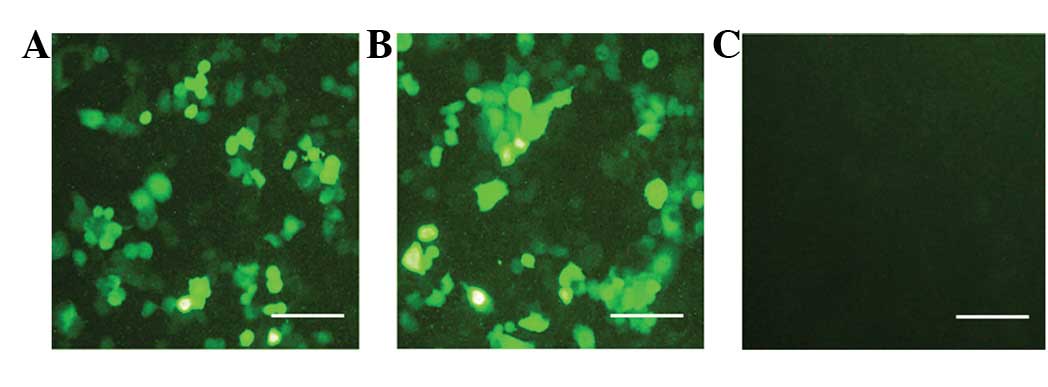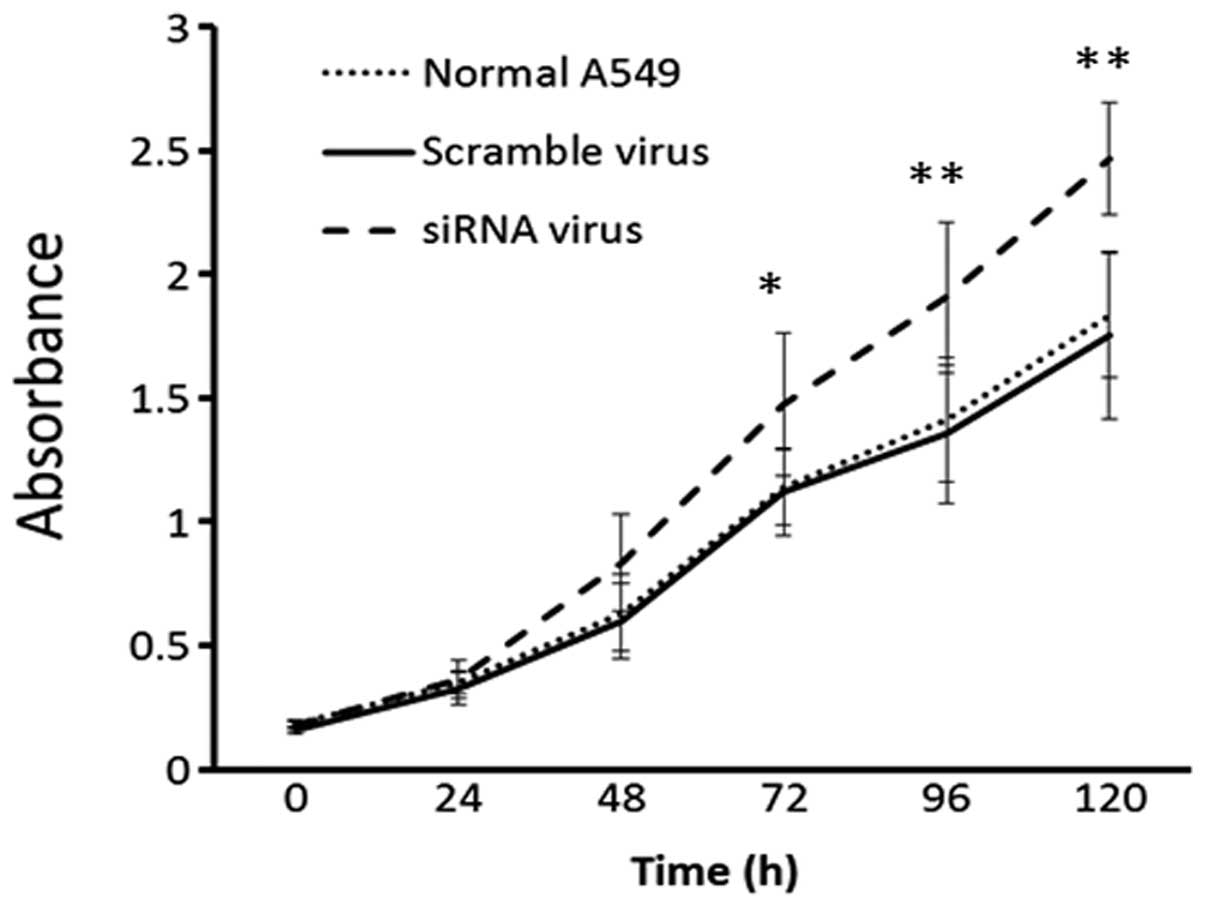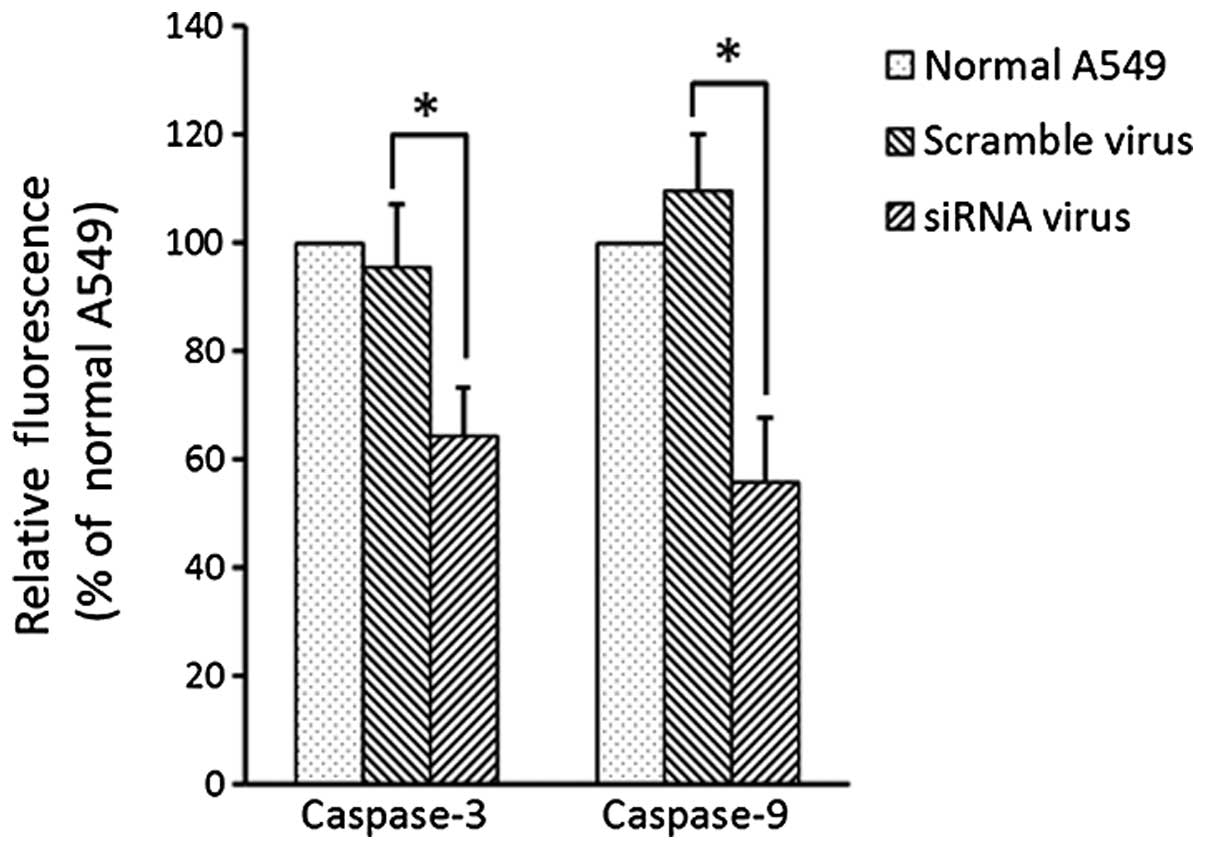Knockdown of autophagy-related gene BECLIN1 promotes cell growth and inhibits apoptosis in the A549 human lung cancer cell line
- Authors:
- Published online on: March 19, 2013 https://doi.org/10.3892/mmr.2013.1379
- Pages: 1501-1505
Abstract
Introduction
Autophagy is the major cellular pathway for the degradation of long-lived proteins and cytoplasmic organelles (1). Autophagy is becoming an important area in cancer research (2,3). Abnormal autophagy has certain associations with the formation of tumors (4,5), however, autophagy in lung cancer has not yet been studied.
BECLIN-1 (the mammalian counterpart of the yeast Atg6 gene), which is part of a type III phosphatidylinositol 3-kinase complex, is required for autophagic vesicle formation (6,7). BECLIN1 suppresses tumor formation via the lysosomal degradation pathway (8). BECLIN1 is monoallelically deleted in ~75% of ovarian cancers (9,10), 50% of breast cancers (11) and 40% of prostate cancers (12). The expression of BECLIN1 has been observed to be significantly reduced in non-small cell lung cancer (NSCLC) compared with that in non-cancerous tissue (13), however, the role of BECLIN1 in lung cancer is unclear. In the present study, BECLIN1 was knocked down in the A549 human lung cancer cell line and its role in cell proliferation and apoptosis was studied.
Materials and methods
Main reagents
The lentiviral small interfering (si)RNA pRNAT-U6.2/Lenti vectors were obtained from GenScript Biotechnology (Piscataway, NJ, USA). The lentiviral packaging cell line 293T and the human lung cancer cell line A549 were purchased from the China Center for Type Culture Collection (CCTCC; Wuhan, Hubei, China). The E. coli DH5α restriction enzymes (BamHI and XhoI) and the T4 DNA ligase were purchased from Promega (Madison, WI, USA). The RPMI-1640 medium and the fetal bovine serum (FBS) were purchased from Hyclone Biotechnology (Waltham, MA, USA). The liposomes (Lipofectamine™ 2000) and G418 were purchased from Invitrogen Biotechnology (Carlsbad, CA, USA). The RNA Extraction, Plasmid DNA Extraction and Gel DNA Isolation kits were obtained from Qiagen Biotechnology (Hilden, Germany). The study was approved by the ethics committee of Zhengzhou University.
Construction of the siRNA plasmid against BECLIN1
Promega, Ambion and Invitrogen siRNA target sequence analysis and design software were used to scan the human-specific BECLIN1 cDNA coding sequences (NM_003766). The siRNA target sequences were based on basic design principles and a NCBI Basic Local Alignment Search Tool (BLAST) homology analysis. The target sequences were ascertained in 356–374 bits (GAGAGGAGCCATTTATTGA). The small hairpin (sh)DNA single-chains were synthesized and BamHI and XhoI enzyme residues were added at the two ends. This process was performed by Shanghai Bio-engineering Biotechnology (Shanghai, China). The designed sequences encoding the region of BECLIN1 were inserted between the BamHI and XhoI sites of the pRNAT-U6.2/Lenti plasmid. Competent E.coli were transformed with the recombinants following the manufacturer's recommendations. The positive clones were confirmed by PCR amplification screening and sequencing.
siRNA transfection
Three recombinant lentiviral vectors, empty lentiviral vectors and secondary packaging plasmids were co-transfected into the 293T cells using 36 ml Lipofectamine 2000 reagent, according to the manufacturer's instructions. The obtained BECN1 siRNA lentiviral fake virus particle solutions were designated as Lv-si356 and the Lv-control and were stored at −80°C until use. The human NSCLC A549 cell lines were cultured in RPMI-1640 medium supplemented with 10% defined FBS. The day prior to infection, the cells were plated into a tissue culture plate to 80% confluence. The human NSCLC A549 cell lines were infected by the Lv-si356- and Lv-Control-prepared lentiviral particles. After 24 h, the medium was replaced and the culture was continued. To obtain a stable infection, the cell lines were screened by G418 for 3 weeks.
RNA isolation and cDNA synthesis
Total RNA was isolated using TRIzol reagent (Invitrogen) following the manufacturer's instructions. The amount of RNA was measured spectrophotometrically by absorbance at 260 nm and the purity of the RNA was estimated by the ratio of the absorbance at A260/280. Reverse transcription of 2 μg total RNA was performed with Moloney murine leukemia virus (MMLV) reverse transcriptase (Promega, USA) using oligo (dT)18 (Promega) as the reverse transcription primer. The reaction conditions for the reverse transcription were as follows: 2 μg of total RNA was incubated with 100 pmol/l oligo (dT)18 primer at 72°C for 10 min and rapidly chilled on ice, then 2 μl 10 mM dNTPs (Promega) and 4 μl 5X MMLV buffer (Promega) were added. The mixtures were incubated at 37°C for 5 min. The mixture containing 200 units Moloney murine leukemia virus reverse transcriptase (Promega) was run at 42°C for 1 h. The reaction was then heated at 72°C for 10 min and stored at −20°C until use.
Quantitative real-time reverse transcription (RT)-PCR
To quantitatively determine the level of the mRNA expression of BECLIN1, the primer pairs were tested empirically for amplification from 100 ng cDNA. The optimal annealing temperature was determined by testing the generation of a single band of the primers on the gels and then a specific primer was successfully identified for BECLIN1. Quantitative real-time PCR reactions were performed on the ABI Prism 7000 Sequence Detection System (Applied Biosystems, Foster City, CA, USA). For the SYBR-Green II-based quantitative real-time PCR reactions (Takara, Shiga, Japan), each 30 μl reaction contained 0.4 μM primer pairs, 100 ng cDNA, 15 μl SYBR-Green, 0.6 μl ROX as a fluorescence internal control and ddH2O. The primers were as follows: BECLIN1 forward, 5′-GGCTGAGAGACTGGATCAGG-3′ and reverse, 5′-CTGCGTCTGGGCATAACG-3′; GAPDH forward, 5′-GGACTGACCTGCCGTCTAG-3′ and reverse, 5′-TAGCCCAGGATGCCCTTGAG-3′. The amplification program comprised two stages, with an initial 95°C Taq activation stage for 10 min followed by 45 cycles of 95°C denaturation for 5 sec and 60°C annealing for 35 sec. Subsequent to the amplification, a melting curve analysis was performed by collecting fluorescence data. GAPDH served as an internal control. The comparative threshold cycle (2−ΔΔCT) method was used to enable quantification of the mRNA of these genes. All sample analyses were performed in duplicate. The relative amount of the target gene was calculated using the 2−ΔΔCT method. The relative amplification efficiencies of the primers were tested and shown to be similar.
Western blotting
The uninfected A549 cells and the four groups of infected cells were added into the RLT buffer. Each group of cells was harvested and the protein concentrations were determined with a Bicinchoninic Acid (BCA) Protein Assay kit. The samples were dissolved in loading buffer, boiled for 5 min and then loaded onto 10% sodium dodecyl sulfate-polyacrylamide gel electrophoresis (SDS-PAGE). The protein bands were transferred onto a polyvinylidene difluoride membrane, which was blocked overnight at 4°C by Tris-buffered saline with Tween 20 (TBST) containing 5% skimmed milk. The blocked membranes were then incubated with rat anti-human BECLIN1 antibodies (1:150) for 2 h. The blocked membranes were then washed three times and incubated with horseradish peroxidase-conjugated rabbit anti-rat antibodies (1:2000) for 1 h. The bands were visualized using 3,3′-diaminobenzidine (DAB).
3-(4,5-dimethylthiazol-2-yl)-2,5-diphenyltetrazolium bromide (MTT) method
The cells were seeded onto 96-well plates at a density of 5×104 cells per well in 100 μl medium. All the cells were maintained in a humidified incubator at 37°C with 5% CO2. A total of 20 μl MTT (5 g/l) was added to each well and the absorbance at 570 nm was measured by a microplate reader. Subsequent to 4 h incubation, the number of surviving cells was measured. There were 5 parallel wells for each group.
Detection of apoptosis by flow cytometry
Subsequent to 48-h incubation, each group of cells was digested by trypsin. The cells were further incubated at a density of 5×105–1×106/ml nutrient solution containing 75% cold ethanol overnight. Subsequent to centrifugation, 1 ml of the cells were fixed with 100 μl RNA enzymes (1 mg/ml) at 37°C for 30 min. Then 100 μl 10 μg/ml propidium iodide (PI) dye liquor was added in the dark. Following fixation, the cells were incubated in the dark for 30 min. The samples were filtered through a 300 mesh nylon net, then the cell apoptosis rates were detected by flow cytometry.
Detection of active caspase-3 and caspase-9
Each group of ~5×105 cells was centrifuged at 500 × g for 5 min. The collected cells were fixed into ice cold cell lysate at a density of 50 μl/2×105 cells for 10 min. The microtubes were centrifuged at 20,000 × g for 5 min, maintaining a consistent temperature of 4°C. Thereafter, the supernatants were transferred to another set of ice-cold microtubes. The 50 μl samples were pipetted into a 96-well plate, mixed and sealed with paraffin wax. Subsequent to a 2-h incubation in the dark, the fluorescence was determined by a plate reader using an excitation wavelength of 380 nm and an emission wavelength of 460 nm.
Statistical analysis
Statistical analyses were performed using SPSS 13.0 (SPSS, Chicago, IL, USA). Quantitative data are presented as the mean ± standard deviation. Comparisons among all the groups were performed with a one-way analysis of variance (ANOVA) test. Comparisons between two groups were evaluated with a t-test.
Results
Lentivirus-mediated siRNA vector transfection in the A549 human lung cancer cell line
Following transfection with the siRNA virus against BECLIN1 for 48 h, the A549 cells expressed enhanced green fluorescent protein (EGFP). In total, >90% of the cells were EGFP-positive in the cell culture (Fig. 1). Subsequent to 2 weeks of G418 selection, the BECLIN1 knockdown A549 cell line was established.
Decrease of BECLIN1 expression following siRNA virus transfection in the A549 cells
Subsequent to transfection with the siRNA and scramble viruses for 48 h, BECLIN1 expression was detected using RT-PCR and western blotting (Fig. 2). The mRNA and protein expression of BECLIN1 decreased in the siRNA virus-transfected A549 cells.
Knockdown of BECLIN1 increases A549 cell proliferation
Cell proliferation was detected by MTT assay in the A549 cells transfected with the siRNA or scramble viruses. Normal A549 cells were assayed as the blank control. The knockdown of BECLIN1 increased cell proliferation significantly (Fig. 3).
Knockdown of BECLIN1 inhibits apoptosis in the A549 cells
Apoptosis was detected by PI staining and flow cytometry in the A549 cells transfected with the siRNA or scramble viruses. Normal A549 cells were assayed as the blank control. The apoptosis index (AI) was less in the BECLIN1-knockdown A549 cells than that in the scramble virus-transfected A549 cells and blank controls (P<0.05; Fig. 4).
Knockdown of BECLIN1 inhibits the activity of caspase-3 and caspase-9
The activity of caspase-3 and caspase-9 decreased in the A549 cells following siRNA transfection in contrast with the activity in the normal A549 cells and the A549 cells following scramble transfection (Fig. 5). There was no difference in the activity of caspase-3 and caspase-9 between the normal A549 and scramble virus-transfected A549 cells.
Discussion
The role of autophagy in tumorigenesis is controversial. Autophagy inhibitors (chloroquine) and autophagy promoters (rapamycin) block tumorigenesis by an unknown mechanism(s) (14,15). This is known as the ‘Autophagy Paradox’. Little is known about the role of autophagy in the tumorigenesis of NSCLC.
BECLIN1 is a key regulator of autophagy (16) and is involved in cell proliferation and tumor formation. BECLIN1 triggers autophagy in human breast carcinoma cells: this autophagy-promoting activity was observed to be associated with the inhibition of cell proliferation in vitro and with tumorigenesis in nude mice (17). Exogenous BECLIN1 expression in MCF-7 breast cancer cells inhibits the cell proliferation and tumorigenesis of these cells (17). In BECLIN1-knockout transgenic mice, the incidence of lung adenocarcinoma, liver cancer and lymphoma increases significantly (18,19). The expression of BECLIN1 is significantly decreased in lung cancer tissues, suggesting that autophagy may be involved in the pathogenesis of lung cancer (20). In the present study, BECLIN1 knockdown increased cell proliferation in the A549 cells. This suggested that BECLIN1 expression may be a significant factor in maintaining the normal level of cell proliferation and that the downregulation or depletion of BECLIN1 in lung cancer may be an etiology responsible for the increased cell proliferation in cancer.
Certain studies have demonstrated the paradoxical correlation between BECLIN1 and apoptosis. Liang et al(17) showed that the BECLIN1 gene reduced apoptosis of the central nervous system. Wang (7) demonstrated that the depletion of BECLIN1 activated apoptosis. However, BECLIN1 was also suggested to bind the Bcl-2 family members, which may have a direct role in initiating apoptotic signaling (21,22). In the present study, the inhibition of apoptosis and the decrease in caspase-3 and caspase-9 activity by BECLIN1 knockdown was validated in the A549 cells. It appears that BECLIN1 may play a different role in the regulation of apoptosis, which therefore requires further elucidation. When considering the promotive effect of BECLIN1 in the apoptosis of the A549 cells, we considered the theory that BECLIN1 downregulation may aid lung cancer cells to escape the body's normal clearance mechanism by apoptosis inhibition. This would contribute to the development of malignant tumors.
Taking these results together, BECLIN1 knockdown increases cell proliferation and decreases apoptosis in lung cancer cells. Therefore, BECLIN1 may be a biological target for gene therapy and the upregulation of BECLIN1 may be a promising treatment method for lung cancer, or even other tumor cells. This may provide further insight into the treatment of cancer.
Acknowledgements
The authors would like to express their particular appreciation to Dr Yongmin Liu who provided statistical assistance.
References
|
Kanzawa T, Germano IM, Komata T, Ito H, Kondo Y and Kondo S: Role of autophagy in temozolomide-induced cytotoxicity for malignant glioma cells. Cell Death Differ. 11:448–457. 2004. View Article : Google Scholar : PubMed/NCBI | |
|
Carew JS, Kelly KR and Nawrocki ST: Autophagy as a target for cancer therapy: new developments. Cancer Manag Res. 4:357–365. 2012. | |
|
Meschini S, Condello M, Lista P and Arancia G: Autophagy: molecular mechanisms and their implications for anticancer therapies. Curr Cancer Drug Targets. 11:357–379. 2011. View Article : Google Scholar : PubMed/NCBI | |
|
Yang ZJ, Chee CE, Huang S and Sinicrope FA: The role of autophagy in cancer: therapeutic implications. Mol Cancer Ther. 10:1533–1541. 2011. View Article : Google Scholar : PubMed/NCBI | |
|
Lockshin RA and Zakeri Z: Caspase-independent cell deaths. Curr Opin Cell Biol. 14:727–733. 2002. View Article : Google Scholar : PubMed/NCBI | |
|
Sun Q, Fan W and Zhong Q: Regulation of Beclin 1 in autophagy. Autophagy. 5:713–716. 2009. View Article : Google Scholar : PubMed/NCBI | |
|
Wang J: Beclin 1 bridges autophagy, apoptosis and differentiation. Autophagy. 4:947–948. 2008. View Article : Google Scholar : PubMed/NCBI | |
|
Shintani T and Klionsky DJ: Autophagy in health and disease: a double-edged sword. Science. 306:990–995. 2004. View Article : Google Scholar : PubMed/NCBI | |
|
Ibragimova I and Cairns P: Assays for hypermethylation of the BRCA1 gene promoter in tumor cells to predict sensitivity to PARP-inhibitor therapy. Methods Mol Biol. 780:277–291. 2011. View Article : Google Scholar : PubMed/NCBI | |
|
Tangir J, Muto MG, Berkowitz RS, Welch WR, Bell DA and Mok SC: A 400 kb novel deletion unit centromeric to the BRCA1 gene in sporadic epithelial ovarian cancer. Oncogene. 12:735–740. 1996.PubMed/NCBI | |
|
Saito H, Inazawa J, Saito S, et al: Detailed deletion mapping of chromosome 17q in ovarian and breast cancers: 2-cM region on 17q21.3 often and commonly deleted in tumors. Cancer Res. 53:3382–3385. 1993.PubMed/NCBI | |
|
Gao X, Zacharek A, Salkowski A, et al: Loss of heterozygosity of the BRCA1 and other loci on chromosome 17q in human prostate cancer. Cancer Res. 55:1002–1005. 1995.PubMed/NCBI | |
|
Liu Q, Wang JJ, Pan YC, Meng LF, Zhan X and Zheng QF: Expression of autophagy-related genes Beclin1 and MAPLC3 in non-small cell lung cancer. Ai Zheng. 27:25–29. 2008.(In Chinese). | |
|
Martinez-Outschoorn UE, Whitaker-Menezes D, Pavlides S, et al: The autophagic tumor stroma model of cancer or ‘battery-operated tumor growth’: a simple solution to the autophagy paradox. Cell Cycle. 9:4297–4306. 2010. | |
|
Maycotte P, Aryal S, Cummings CT, Thorburn J, Morgan MJ and Thorburn A: Chloroquine sensitizes breast cancer cells to chemotherapy independent of autophagy. Autophagy. 8:200–212. 2012. View Article : Google Scholar : PubMed/NCBI | |
|
Ruck A, Attonito J, Garces KT, et al: The Atg6/Vps30/Beclin 1 ortholog BEC-1 mediates endocytic retrograde transport in addition to autophagy in C. elegans. Autophagy. 7:386–400. 2011. View Article : Google Scholar : PubMed/NCBI | |
|
Liang XH, Jackson S, Seaman M, et al: Induction of autophagy and inhibition of tumorigenesis by beclin 1. Nature. 402:672–676. 1999. View Article : Google Scholar : PubMed/NCBI | |
|
Lozy F and Karantza V: Autophagy and cancer cell metabolism. Semin Cell Dev Biol. 23:395–401. 2012. View Article : Google Scholar | |
|
Yue Z, Jin S, Yang C, Levine AJ and Heintz N: Beclin 1, an autophagy gene essential for early embryonic development, is a haploinsufficient tumor suppressor. Proc Natl Acad Sci USA. 100:15077–15082. 2003. View Article : Google Scholar : PubMed/NCBI | |
|
Jiang ZF, Shao LJ, Wang WM, Yan XB and Liu RY: Decreased expression of Beclin-1 and LC3 in human lung cancer. Mol Biol Rep. 39:259–267. 2012. View Article : Google Scholar : PubMed/NCBI | |
|
Oberstein A, Jeffrey PD and Shi Y: Crystal structure of the Bcl-XL-Beclin 1 peptide complex: Beclin 1 is a novel BH3-only protein. J Biol Chem. 282:13123–13132. 2007. View Article : Google Scholar : PubMed/NCBI | |
|
Maiuri MC, Le Toumelin G, Criollo A, et al: Functional and physical interaction between Bcl-X(L) and a BH3-like domain in Beclin-1. EMBO J. 26:2527–2539. 2007. View Article : Google Scholar : PubMed/NCBI |














